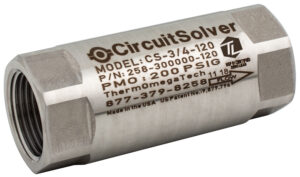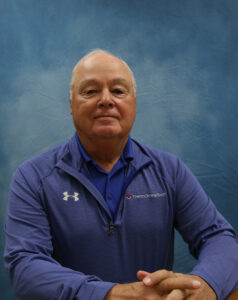The CircuitSolver thermostatic balancing valve has been overcoming water balancing issues for over a decade.
More than ten years ago, ThermOmegaTech developed the CircuitSolver, the first thermostatic balancing valve used in domestic hot water systems to overcome the challenges inherent in traditional manual balancing methods.
This year, ThermOmegaTech is celebrating this milestone.
PHCP Pros recently spoke with Tom Ruggierio, Director of Sales for Commercial Plumbing at ThermOmegaTech and the subject matter expert on thermostatic balancing valve technology and the CircuitSolver thermostatic balancing valve.

PHCP Pros: Who proposed the idea of the thermostatic balancing valve?
Tom Ruggierio: A plumbing sales rep in Texas named Bob Anderson presented the concept of using thermostatic technology to balance domestic hot water systems. That was the genesis of this product.
PHCP Pros: How does CircuitSolver differ from manual or pressure-independent balancing valves?
TR: The manual balancing valves and the pressure-independent valves are both flow devices; the challenge is determining how much flow is required in a branch or riser to offset the heat loss. Building engineers constantly try to determine how much flow they need to cancel the heat loss by manipulating the manual balancing valve or selecting specific flow cartridges with pressure-independent valves.
Two characteristics separate CircuitSolver from the other types of balancing valves. First, it is inherently a temperature device solving a temperature problem. The other two devices are flow devices trying to solve a temperature problem indirectly. Second, CircuitSolver is dynamic, continuously changing the flow rate to maintain a constant temperature. The other types are fixed devices; once you set them, they do not react to changing conditions that may require re-balancing.
PHCP Pros: How does CircuitSolver address the temperature loss problem?
TR: With temperature loss, you’re trying to figure out how much flow you need in a branch or riser. The higher the flow rate, the faster that water will get from point A to point B. CircuitSolver will dynamically adjust the valve’s position to increase or decrease the flow as required to offset the heat loss and maintain a constant temperature.
PHCP Pros: ThermOmegaTech is celebrating CircuitSolver’s 10-plus years of active use in the plumbing and construction industry. How has CircuitSolver evolved over the years?
TR: We have enhanced the product by adding different features based on the feedback from engineers and contractors. We added an integrated union and check valve to CircuitSolver about five years ago. Combining these elements into one valve provides a solution with a better cost-benefit and a more integrated solution with fewer leak points.
In addition, we started creating assemblies with ball valves, strainers, and thermometers, providing temperature measurement capability to the CircuitSolver. We also added several different types of end connections.
Engineers and contractors prefer these assemblies because the trades are hurting for qualified plumbers. Having these assemblies already premanufactured and tested at our Bucks County facility gives the engineer the comfort that when they specify the solution, it will be installed as they designed it; contractors like it because they don’t need to worry about leaks in the assembly.
PHCP Pros: How many variations of the CircuitSolver are out there?
TR: The basic CircuitSolver, which has no union or check valve, ranges from 1/2 inch to 2 inches. The CircuitSolver with the union and check valve comes in 1/2-inch, 3/4-inch, and 1-inch sizes. The assemblies are combined with our union and ball valves with optional strainers and thermometers; all those can be combined with different end connections.
There are a large number of combinations. The enhancements we’ve added over the last ten years result from us listening to the plumbing community and responding to their needs.
PHCP Pros: What’s the latest evolution of the CircuitSolver?
TR: Within the last year, we released a CircuitSolver thermostatic cold water balancing valve used for balancing cold water in domestic water systems.
This product is still in its infancy but has been installed in several VA hospitals to recirculate cold water. This reverse-acting valve works the opposite of a hot water valve because it starts closing its position based on cooling water. Recirculating the cold water in the system eliminates stagnant lines and helps mitigate Legionella and other waterborne pathogens that can develop in the plumbing system, creating health risks.
It also helps keep chlorine distributed throughout the system since the chlorine can start dissipating if it’s not recycled throughout the cold water, and it keeps the temperature of the system more uniform.
PHCP Pros: What would you tell someone specifying a large building on why they should use the CircuitSolver?
TR: Compared to other balancing valves, this system is automatically balanced based on the water’s temperature.
Imagine having a large hotel or a hospital with up to 200 balancing valves. To try and manually balance the system and do it correctly, as well as be able to react to system changes, would be a daunting task. CircuitSolver does it effortlessly. In addition, it eliminates callbacks, which contractors generally think is its most significant advantage.
CircuitSolver is the best solution for anyone challenged with trying to balance a hot water system with a large number of balancing valves. That’s what contractors like about it; they install it and walk away, and the system balances itself within a few hours.
PHCP Pros: Reflecting, what has the uptick been for this technology?
TR: The plumbing industry is very conservative and unwilling to make changes, so you can imagine what it was like when we introduced this new technology ten years ago. We were a new company in the plumbing industry. We had a lot of resistance from plumbing engineers to try our CircuitSolver because it was an unproven technology for balancing domestic hot water systems, which is understandable.
The primary way we got our start early on was strictly out of desperation! There would be situations where people had hot water issues and couldn’t balance the system. They tried all different types of things — changing pumps, water temperature, rebalancing, and rebalancing — to no avail.
They turned to the internet and Googled balancing valves. CircuitSolver appeared in their search. By that point, they were willing to try anything. So, after speaking with us, they tried CircuitSolver, which proved successful. That’s how we started building our success — one installation at a time.
It’s how we overcame the resistance from the plumbing industry to try new technology. Now, our thermostatic balancing valves are the solution of choice when balancing hot water systems.
PHCP Pros: How does CircuitSolver comply with codes or standards?
TR: CircuitSolver has NSF 61 certification. Most states mandate that components used in domestic hot water systems have NSF 61 certification. This certification covers two significant areas: having metal components within the valve that have low/no lead, such as stainless steel, and ensuring that other types of components used in the valves, such as plastic parts, O-rings, and sealants, will not leach harmful chemicals into the potable water system.
This past year, we worked with IAPMO and ASSE to create a thermostatic balancing valve standard. We’re working to get that standard into code to be mandated. It is a big step for the industry, which presently has no standards for any balancing valves. Our goal is to keep everyone safe and comfortable.
PHCP Pros: Is there anything you’d like to add?

TR: I want to thank those in the plumbing community for their confidence in our products over the past 10-plus years. We have loyal customers who were naysayers ten years ago; now, they won’t use anything else but CircuitSolver.
We’re very grateful for all the effort our sales reps have put in to help promote this innovative solution and for the engineers and contractors who adopted our CircuitSolver products and used our thermostatic balancing valves religiously.
We thank you!
This feature originally ran on September 4, 2023, with PHCP Pros. Read the full feature here.
